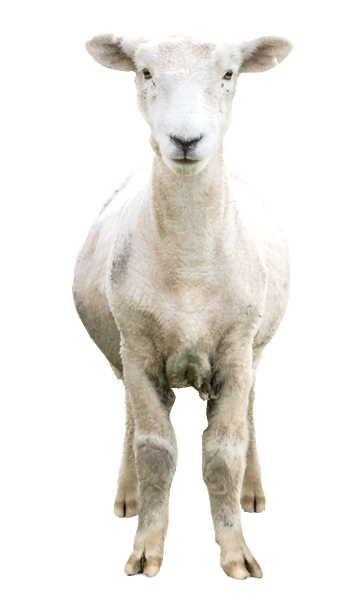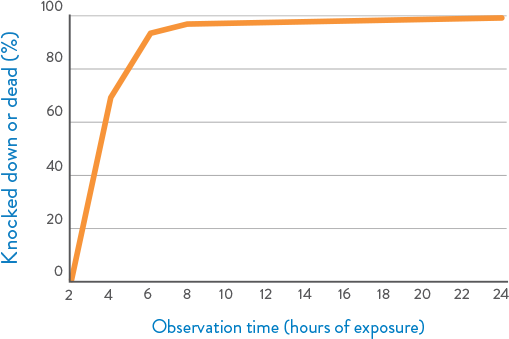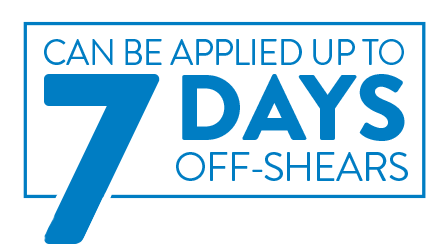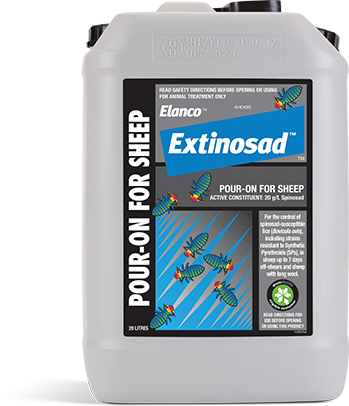
Rate of knockdown in sheep lice exposed to spinosad (40mg/L)1

^40 mg/L was the minimum concentration of spinosad required in a lab study to kill 100% of a fully susceptible lice strain
STARTS KILLING LICE WITHIN HOURS
Extinosad Pour-On contains the active ingredient, spinosad, which provides rapid knockdown control of lice, including adults and nymphs. A laboratory study found spinosad started killing lice within hours of exposure, with 70% of exposed lice 'knocked down' or dead within 4 hours. This figure increased to 98% within 8 hours. All adult and nymphal lice were dead within 24 hours of contact.¹Read More
Unique mode
of action
Extinosad Pour-On has a unique mode of action.² Upon contact or ingestion, spinosad causes involuntary and prolonged tremors in the nervous system of target species, leading to irreversible paralysis and death. Rotation between products with different modes of action may prolong the effective life of all available treatments.³
Read More
No Known Field Resistance
Extinosad Pour-On is a member of the spinosyn chemical group, which is unrelated to any other chemical group used for the control of sheep lice. Its unique mode of action kills strains of lice that are resistant to synthetic pyrethroids.¹ No field strains of lice resistant to spinosad have been identified in Australia, so you can have complete confidence that Extinosad Pour-On will provide effective lice control.Read More
Control That Goes
The Distance
Extinosad Pour-On provides effective lice control when applied off-shears. Extensive research and commercial experience have confirmed no lice will be detected for a minimum of 20 weeks after application off-shears in accordance with label directions.⁴ These trials confirm Extinosad Pour-On controls any nymphs emerging from eggs that can hatch up to 14 days after treatment.
Read More
6 Month Off-Shears Guarantee*
Elanco guarantees that when Extinosad Pour-On is applied correctly to sheep off-shears, there will be no detectable lice present on sheep six months after treatment. *To qualify, simply register your purchase within 14 days of application and apply Extinosad Pour-On in accordance with the label directions.Read More
Maximum
Flexibility
Extinosad Pour-On can be applied up to seven days off-shears or to sheep with long wool. It has no withholding period for wool and an Export Slaughter Interval (ESI) of only 21 days when applied off-shears and to suckling lambs (unshorn), giving you maximum flexibility in your management and marketing options.
Read More
Good Management Practices
Good management practices is essential to ensuring sheep remain lice free through to the next shearing Read More
 Treat all sheep on the property at the same time. Avoid split shearing
Treat all sheep on the property at the same time. Avoid split shearing
 Muster each paddock thoroughly to ensure all sheep are treated
Muster each paddock thoroughly to ensure all sheep are treated
 Conduct a second muster if necessary
Conduct a second muster if necessary
 Check ALL fences (especially boundary fences) to prevent untreated or lice-infested sheep from joining treated mobs
Check ALL fences (especially boundary fences) to prevent untreated or lice-infested sheep from joining treated mobs
 Do not mix treated sheep with untreated sheep, infested sheep or those of unknown lice status
Do not mix treated sheep with untreated sheep, infested sheep or those of unknown lice status
 Ensure sheep are cleanly shorn. Grass seeds, lumpy wool or flystrike can hinder shearing and may impede the spread of Extinosad Pour-On
Ensure sheep are cleanly shorn. Grass seeds, lumpy wool or flystrike can hinder shearing and may impede the spread of Extinosad Pour-On
 Sheep that require treatment with Extinosad™ Pour-On or Extinosad Eliminator for long wool lice control should be retreated with an off-shears lousicide at the next shearing
Sheep that require treatment with Extinosad™ Pour-On or Extinosad Eliminator for long wool lice control should be retreated with an off-shears lousicide at the next shearing
 Avoid treating ewes within six weeks of the commencement of lambing, as live lice may infest the lambs from these ewes (off-shears recommendation)
Avoid treating ewes within six weeks of the commencement of lambing, as live lice may infest the lambs from these ewes (off-shears recommendation)
 If ewes have lambs at foot at shearing time, ensure either that the unshorn lambs are treated at the suckling lamb (unshorn) dose rate or shear the lambs and treat using the off shears dose rate table
If ewes have lambs at foot at shearing time, ensure either that the unshorn lambs are treated at the suckling lamb (unshorn) dose rate or shear the lambs and treat using the off shears dose rate table

References: 1. Levot, G. (2008). Speed of action and in vitro efficacy of spinosad against sheep body lice, Bovicola ovis (Schrank) (Phthiraptera: Trichodectidae), resistant to pyrethroid, organophosphate or insect growth regulator insecticides. Aust. J Entomol. 47:251-255. 2. Cisneros, J et al. (2002). Toxic effects of spinosad on predatory insects. Biol. Control 23:156-163. 3. James, P. (2013). Preventing resistance in sheep lice, www.liceboss.com.au (AWI, Sheep CRC). 4. Elanco data on file. Part 8 Efficacy and Safety Summary from the Submission dossier to the APVMA.
